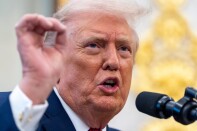Truth matters. Community matters. Your support makes both possible. LAist is one of the few places where news remains independent and free from political and corporate influence. Stand up for truth and for LAist. Make your year-end tax-deductible gift now.
What to do if you don't have a REAL ID yet, and which documents still work

Enforcement of the federal REAL ID law starts May 7, nearly 20 years after its passage. That means travelers will need an identification card that complies with the REAL ID law in order to board a domestic flight and enter certain federal facilities.
Standard driver's licenses and state IDs will no longer be accepted at airport security, according to the Department of Homeland Security. REAL IDs resemble regular driver's licenses but require more documentation, like a valid Social Security number, more security screening and feature a golden star. Rules vary by state.
"It's a way for the government to have unified standards for every state ID," said Clint Henderson, managing editor at The Points Guy, a travel magazine.
Though passed after 9/11, Congress' concerns about unreliable IDs go back even earlier, to the 1995 Oklahoma City bombing. "Because the Oklahoma City bombers bought their fertilizer using a counterfeit ID made by a wife of one of them on an ironing board," said Brian Zimmer, who helped draft the law while working as researcher for the House Judiciary committee, in an interview with NPR's All Things Considered.
States differ in how they've implemented the law. Some, like Washington, offer enhanced driver's licenses, but only to U.S. citizens. Noncitizens with legal status can often obtain a REAL ID with extra documentation, but those living in the U.S. without legal status cannot. "It will make it more difficult for people to come up with an acceptable ID," said Tanya Broder of the National Immigration Law Center.
While the deadline is almost here, the national system remains a work in progress. As NPR's Martin Kaste reports, the TSA has begun auditing compliance, starting with the most prepared states and giving others more time to meet federal standards.
Henderson offered these tips for travelers ahead of the change:
What to do if you don't have a REAL ID
Don't panic. The good news, Henderson said, is there's about a two-year "wiggle room period" that gives airports discretion, on a case-by-case basis, to subject travelers to additional screening instead of requiring a REAL ID. You could still be turned away, but systems are expected to allow passage with extra screening.
Henderson said you should expect some backups when the policy takes effect May 7.
What you can bring instead
Passports and passport cards are compliant, as are Global Entry, NEXUS, FAST, SENTRI, DoD IDs, green cards, and enhanced driver's licenses issued by some states, Henderson said.
You can see the full list of accepted IDs on the TSA website.
Consider flying from a smaller airport
TSA agents at larger airports may have more training on REAL ID, Henderson said, but they're also going to be dealing with so many more passengers — and likely more headaches during this transition.
"If you can start from a smaller airport, you're going to find that it's much easier to get through," Henderson said.
Claire Murashima produced the radio version of this story. It was adapted for the web and edited by Majd Al-Waheidi and Obed Manuel.
Copyright 2025 NPR
Corrected May 12, 2025 at 2:26 PM PDT
This web story has been updated to clarify that Brian Zimmer spoke to NPR's Martin Kaste and was not interviewed by All Things Considered.
Correction
Previously posted on May 8, 2025: The audio version of this story incorrectly says that “anyone who's getting a driver's license or a state ID renewed” is eligible for a REAL ID. In fact, some states issue versions of their driver’s licenses or state IDs that are not REAL ID-compliant, often to people in the U.S. without legal status, and people renewing those licenses may not be eligible for a REAL ID.










